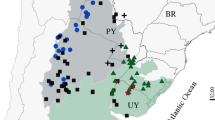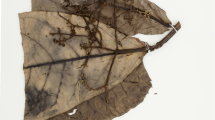Abstract
Persea is a genus of Lauraceae with about 101 accepted species from the Americas and another two from the Macaronesian Islands and the Azores. The New World species occur in subtropical to tropical regions from sea level to ca. 4000 m. Recent field work in southeastern Brazil, as well as the study of 1432 collections of Brazilian Persea, revealed a new species that we describe here as Persea quarciticola. The new species belongs to Persea subg. Eriodaphne. It is restricted to the ‘morros de sal’ (mountains of quartz) of Vargem Alta, Espírito Santo, between 600 and 800 m. We provide a complete description of the new species, including illustrations, a distribution map, and discussion on its putative relationships within the genus.


Similar content being viewed by others
Literature Cited
Brade, A.C. 1956. Melastomataceae novae IV. Arquivos do Jardim Botânico do Rio de Janeiro 14: 211–240.
Dutra, V.F., J.C. Guarnier, A.D. Firmino, A.C. Tuler, A.L. Peixoto, C. Kameyama, F.Z. Saiter, F.G. Barroso, G.S. Siqueira, G. Heiden, G.H. Shimizu, H.C. Lima, J.M.L. Gomes, J. Trarbach, J. Rossini, L.C. Marinho, M. Simonelli, M. Ribeiro, P.H.D. Barros, P.M.L.A. Santos, R. Goldenberg & W.C. Cardoso. 2020. Angiospermas eudicotiledôneas ameaçadas de extinção no estado do Espírito Santo. Pp. 192–215 in: C.N. Fraga, M. H. Formigoni & F.G. Chaves (orgs.), Fauna e Flora Ameaçadas de Extinção no Estado do Espírito Santo. Instituto Nacional da Mata Atlântica, Santa Teresa.
Goldenberg, R., L.F. Bacci, T. Bochorny & M. Reginato. 2021. Two new species of Miconia s.lat. (Melastomataceae) from Espírito Santo, Brazil. Nordic Journal of Botany 2021: e03396. https://doi.org/10.1111/njb.03396.
IEMA (Instituto de Meio Ambiente e Recursos Hídricos). 2023. Unidades de Conservação. Available from: https://iema.es.gov.br/unidades-de-conservacao (Accessed: 12 June 2023).
IUCN. 2022. Guidelines for Using the IUCN Red List Categories and Criteria, version 15.1. Prepared by the IUCN Standards and Petitions Committee. Downloadable from: http://www.iucnredlist.org/documents/RedListGuidelines.pdf.
Kopp, L.E. 1966. A taxonomic revision of the genus Persea in the Western Hemisphere. (Persea-Lauraceae). Memoirs of the New York Botanical Garden 14: 1–120.
Kostermans, A.J.G.H. 1993. Mutisiopersea Kostermans, a new genus in Lauraceae. Rheedea 3: 132–135. http://rheedea.in/journal/NqaWYCyF.
Li, L., J. Li, J.G. Rohwer, H. van der Werff, Z.H. Wang & H.W. Li. 2011. Molecular phylogenetic analysis of the Persea group (Lauraceae) and its biogeographic implications on the evolution of tropical and subtropical Amphi-Pacific disjunctions. American Journal of Botany 98: 1520–1536. https://doi.org/10.3732/ajb.1100006.
Mabberley, D.J. 2017. Mabberley’s Plant-book, 4th ed. Cambridge University Press, Cambridge. https://doi.org/10.1017/9781316335581.
Moraes, P.L.R. de. 2013. The collections of Lauraceae in the Herbarium of Henri Van Heurck (AWH). Plant Ecology and Evolution 146: 360–383. https://doi.org/10.5091/plecevo.2013.859.
Moraes, P.L.R. de. 2022. Leaf venation of living species of Persea (Lauraceae), with taxonomic and nomenclatural notes. Phytotaxa 539: 77–129. https://doi.org/10.11646/phytotaxa.539.2.1.
Moraes, P.L.R. de & M.D. Trinca. 2021. Persea psammophila (Lauraceae), a new species from Bahia, Brazil. Systematic Botany 46: 280–295. https://doi.org/10.1600/036364421X16231782047488.
Moraes, P.L.R. de & M.C. Vergne. 2019. A synopsis of Lauraceae (excluding Ocotea) from the Reserva Natural Vale, Linhares, Espírito Santo, Brazil. Feddes Repertorium 129: 247–303. https://doi.org/10.1002/fedr.201800015.
Pena, N.T.L. & C.V. Miranda. 2020. Ferns and lycophytes from a forest associated with quartzitic rocky outcrops in southern Espírito Santo, Brazil. Heringeriana 14: 33–48. https://doi.org/10.17648/heringeriana.v14i1.917912.
QGIS Development Team. 2020. QGIS Geographic Information System, version 3.16.7. Open Source Geospatial Foundation Project. http://qgis.osgeo.org.
Rohwer, J.G., J. Li, B. Rudolph, S.A. Schmidt, H. van der Werff, & H.-W. Li. 2009. Is Persea (Lauraceae) monophyletic? Evidence from nuclear ribosomal ITS sequences. Taxon 58: 1153–1167. https://doi.org/10.1002/tax.584009.
Schwartsburd, P.B. & J. Prado. 2017. Flora of Espírito Santo: Oleandraceae. Rodriguésia 68: 1807–1811. https://doi.org/10.1590/2175-7860201768516.
Schwartsburd, P.B., C.V. Miranda & J. Prado. 2016. Oleandra (Oleandraceae) in the Brazilian Atlantic Forest. American Fern Journal 106: 191–205. https://doi.org/10.1640/AFJ-D-16-00004.1.
SFB (Serviço Florestal Brasileiro). 2019. Inventário Florestal Nacional: Espírito Santo: principais resultados. Brasília, DF: MAPA (Série Relatórios Técnicos – IFN). https://snif.florestal.gov.br/images/pdf/publicacoes/periodo_eleitoral/publicacoes_ifn/relatorios/IFN_ES_2017_periodo_eleitoral.pdf (Accessed: 12 June 2023).
Smith, L.B. 1943. Bromeliaceas novas ou interessantes do Brasil—II. Arquivos de Botânica do Estado de S. Paulo, nova série, 1(5): 101–122, tab. 101–134.
Thiers, B. 2023. Index Herbariorum: A Global Directory of Public Herbaria and Associated Staff. New York Botanical Garden’s Virtual Herbarium. http://sweetgum.nybg.org/science/ih/ (Accessed: 29 May 2023).
Trovó, M., C.N. Fraga & P.T. Sano. 2016. Paepalanthus capixaba (Eriocaulaceae), a new microendemic species from Espírito Santo, Brazil. Phytotaxa 258: 83–88. https://doi.org/10.11646/phytotaxa.258.1.6.
van der Werff, H. 2002. A synopsis of Persea (Lauraceae) in Central America. Novon 12: 575–586. https://doi.org/10.2307/3393142.
Vieira, V.S., M.A. Silva, T.R. Corrêa & N.H.B. Lopes. 2018. Mapa geológico do estado do Espírito Santo—Escala 1:400.000. CPRM (Companhia de Pesquisa de Recursos Minerais)—Serviço Geológico do Brasil. https://rigeo.cprm.gov.br/handle/doc/15564 (Accessed: 12 June 2023).
Acknowledgments
We thank Rafael R. Völtz for his help in the field work and the Prefeitura Municipal de Curitiba—Museu Botânico Municipal (MBM) for the logistic support to the field expeditions.
Author information
Authors and Affiliations
Contributions
The contributions of the authors were roughly equal. PLRM conceived the study, compiled the geographical data, collected the morphological data, and wrote the taxonomic treatment and original draft of the manuscript; MLB provided the management for the field expedition, collected and photographed the species in the field, built the map, and prepared the conservation assessment. Both authors contributed to the revision of the manuscript.
Corresponding author
Ethics declarations
Competing interests
The authors have no competing interests to declare that are relevant to the content of this article.
Additional information
Associate Editor: Oscar Toro Núñez
Rights and permissions
Springer Nature or its licensor (e.g. a society or other partner) holds exclusive rights to this article under a publishing agreement with the author(s) or other rightsholder(s); author self-archiving of the accepted manuscript version of this article is solely governed by the terms of such publishing agreement and applicable law.
About this article
Cite this article
de Moraes, P.L.R., Brotto, M.L. Persea quarciticola (Lauraceae), a new species from Espírito Santo, Brazil. Brittonia (2024). https://doi.org/10.1007/s12228-024-09782-2
Received:
Revised:
Accepted:
Published:
DOI: https://doi.org/10.1007/s12228-024-09782-2




